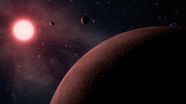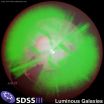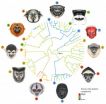(Press-News.org) PASADENA, Calif. -- A team of astronomers led by scientists at the California Institute of Technology (Caltech) has discovered the three smallest confirmed planets ever detected outside our solar system. The three planets, which all orbit a single star, are smaller than Earth and appear to be rocky with a solid surface. Until now, astronomers have found at most only four other rocky planets, also called terrestrial planets, around other stars.
The trio of new planets is too close to the central star to be in its habitable zone—the ring-shaped region around a star where the temperature is mild enough for liquid water, and possibly life, to exist. But the planets are the first rocky ones to be found orbiting a type of dim, small star called a red dwarf, the most common kind in the Milky Way. Their existence suggests that the galaxy could be teeming with similarly rocky planets—and that there's a good chance that many are in the habitable zone.
The red dwarf, called KOI-961, was first flagged as a potential planetary system by the Kepler mission, a space telescope that looks for planets around sunlike stars by scanning the sky for stars that periodically dip in brightness—the result of one or more planets passing in front of them. Although Kepler reported 900 potential planetary systems in February, only about 85 of those were red-dwarf systems. The fact that a relatively small sample of red dwarfs produced three terrestrial planets means that either the Caltech-led team was really lucky or, more likely, that these planets are commonly found around red dwarfs.
"When you combine that with the fact that these are some of the most numerous stars in the galaxy, you realize this type of system could be common," says Philip Muirhead, a postdoctoral scholar at Caltech. "There's no question that it's exciting." Muirhead is the lead author on the paper describing the discovery, which has been accepted by the Astrophysical Journal. The team will also present their results in two talks on January 11 at the meeting of the American Astronomical Society in Austin, Texas.
"Red dwarfs make up eight out of every ten stars in the galaxy," adds John Johnson, assistant professor of astronomy and one of the paper's coauthors. "That boosts the chances of other life being in the universe—that's the ultimate result here. If these planets are as common as they appear—and because red dwarfs themselves are so common—then the whole galaxy must be just swarming with little habitable planets around faint red dwarfs."
This report comes just a few weeks after the Kepler team announced it had detected two rocky planets around a sunlike star—Kepler-20e and Kepler-20f—the first Earth-sized planets ever found and the smallest known at the time. In January 2011, the Kepler team reported the discovery of the first unequivocally rocky planet around another star, Kepler-10b. Another planet—Corot-7b, which was found in 2009—could also be a rocky planet.
With the exception of Kepler-20e, which is about the size of Venus, the other previously discovered planets are all bigger than Earth. All three of the ones found by the Caltech-led team are smaller—the outermost one is about half the size of Earth (similar to Mars) and the other two are three-fourths the size of Earth (smaller than Venus). In fact, the entire KOI-961 planetary system is remarkably tiny. KOI-961 has a diameter one-sixth that of the sun's, making it just 70 percent bigger than Jupiter. Each of the three planets needs less than two days to zip around their star, and all three are about one hundred times closer to that star than Earth is to the sun. And because they're so close to their star, they're hot—the outermost planet is estimated to be about 200 degrees Celsius (400 degrees Fahrenheit) while the innermost planet is a scorching 500 degrees Celsius (more than 900 degrees Fahrenheit).
"The really amazing thing about this system is that the closest size comparison is to Jupiter and its moons," Johnson says. "This is causing me to have to fully recalibrate my notion of planetary and stellar systems."
Kepler's initial measurements—which are automated to help it sift through roughly 150,000 stars—underestimated the size of KOI-961 and any planets it might have had. No one realized this until amateur astronomer and paper coauthor Kevin Apps alerted Muirhead and his team to the idea that KOI-961 bore a remarkable resemblance to another red dwarf called Barnard's Star, a nearby star that's one of the most well-studied. "That's what blew the case wide open," Johnson says.
When the astronomers used telescopes at the Palomar and Keck Observatories to take a closer look at both stars, they found that the two are practically twins. The characteristics of Barnard's Star allowed the team to infer the properties of KOI-961, which is needed to deduce the nature of the planetary system from the star's light curve—a plot of how the star dims over time due to transiting planets. In particular, the depth of the light curve—that is, how much the curve dips—reveals the planets' sizes.
Because the planets are so small, the only way they could have enough gravity to hold themselves together is if they are balls of rock, like Mercury, Venus, Earth, and Mars. "Just three years ago, just talking about a rocky planet would have been pure speculation," Johnson says. "But these are unambiguously rocky."
Still, before they could make any conclusions, the researchers had to confirm that the dips in light detected by Kepler really were due to planets—and not something else, such as a pair of background stars in orbit around each other. To do so, they turned to old photographs taken by Palomar Observatory's 48-inch Samuel Oschin Telescope in 1951. Because KOI-961 is relatively close—about 130 light-years away—it appears to drift across the sky relatively quickly, so that a photo taken in 1951 would show it in a different location than a current image would. By comparing pictures of KOI-961 over the years, astronomers can check whether there are any stars behind it that could produce the light dips they saw. They found none.
Instead of a planetary system, the dips could also be caused by stars in orbit around each other. But the researchers analyzed the statistics of such a scenario and found that it's very unlikely. Combining these statistical results with the observations that show a lack of background stars, the astronomers concluded that the light dips from KOI-961 are indeed produced by three small, terrestrial planets.
INFORMATION:
The other Caltech authors on the Astrophysical Journal paper, "Characterizing the Cool KOIs III. KOI-961: A Small Star with Large Proper Motion and Three Small Planets," are graduate students Tim Morton, John Pineda, Michael Bottom, and David Levitan; postdocs Justin Crepp and Evan Kirby; and astronomer Lee Armus and postdoc Tanio Diaz-Santos of the Infrared Processing and Analysis Center (IPAC) at Caltech. There are ten other authors from the Harvard-Smithsonian Center for Astrophysics, Cornell University, UC Santa Cruz, the American Museum of Natural History, Vanderbilt University, and UC Berkeley. This research was supported by NASA, the National Science Foundation, the National Geographic Society, the Sloan Foundation, the Samuel Oschin Foundation, and the Eastman Kodak Company.
Written by Marcus Woo
Astronomers find 3 smallest planets outside solar system
Discovery may boost likelihood of existence of habitable planets
2012-01-13
ELSE PRESS RELEASES FROM THIS DATE:
Hubble solves mystery on source of supernova in nearby galaxy
2012-01-13
Using NASA's Hubble Space Telescope, astronomers have solved a longstanding mystery on the type of star, or so-called progenitor, which caused a supernova seen in a nearby galaxy. The finding yields new observational data for pinpointing one of several scenarios that trigger such outbursts.
Based on previous observations from ground-based telescopes, astronomers knew the supernova class, called a Type Ia, created a remnant named SNR 0509-67.5, which lies 170,000 light-years away in the Large Magellanic Cloud galaxy.
Theoretically, this kind of supernova explosion is ...
New information on the waste-disposal units of living cells
2012-01-13
Important new information on one of the most critical protein machines in living cells has been reported by a team of researchers with the U.S. Department of Energy's Lawrence Berkeley National Laboratory (Berkeley Lab) and the University of California (UC) Berkeley. The researchers have provided the most detailed look ever at the "regulatory particle" used by the protein machines known as proteasomes to identify and degrade proteins that have been marked for destruction. The activities controlled by this regulatory particle are critical to the quality control of cellular ...
A clue to the GI problems that plague many kids with autism?
2012-01-13
January 11, 2012 -- New research conducted in the Center for Infection and Immunity (CII) at Columbia University's Mailman School of Public Health, reports that children with autism and gastrointestinal disturbances have high levels of a bacterium called Sutterella in their intestines.
Study findings are published online in the journal mBio.
The investigators found that over half of the children diagnosed with autism and gastrointestinal disturbances had Sutterella in intestinal biopsy tissue, while Sutterella was absent in biopsies from typically developing children ...
Treatment with light benefits Alzheimer's patients, Wayne State University finds
2012-01-13
Detroit - Exposure to light appears to have therapeutic effects on Alzheimer's disease patients, a Wayne State University researcher has found.
In a study published recently in the Western Journal of Nursing Research, LuAnn Nowak Etcher, Ph.D., assistant professor of nursing, reported that patients treated with blue-green light were perceived by their caregivers as having improved global functioning.
Caregivers said patients receiving the treatment seemed more awake and alert, were more verbally competent and showed improved recognition, recollection and motor coordination. ...
Rice's 'quantum critical' theory gets experimental boost
2012-01-13
New evidence this week supports a theory developed five years ago at Rice University to explain the electrical properties of several classes of materials -- including unconventional superconductors -- that have long vexed physicists.
The findings in this week's issue of Nature Materials uphold a theory first offered in 2006 by physicist Qimiao Si, Rice's Harry C. and Olga K. Wiess Professor of Physics and Astronomy. They represent an important step toward the ultimate goal of creating a unified theoretical description of the quantum behavior of high-temperature superconductors ...
ISG15: A novel therapeutic target to slow breast cancer cell motility
2012-01-13
Interferon-stimulated gene 15 (ISG15), a ubiquitin like protein, is highly elevated in a variety of cancers including breast cancer. How the elevated ISG15 pathway contributes to tumorigenic phenotypes remains unclear and is the subject of a study published in the January 2012 issue of Experimental Biology and Medicine. Dr. Shyamal Desai and her co-investigators from the Louisiana State University School of Medicine in New Orleans, the University of Pennsylvania School of Medicine in Philadelphia, and the Robert Wood Johnson School of Medicine in New Jersey report that ...
Calculating what's in the universe from the biggest color 3-D map
2012-01-13
Since 2000, the three Sloan Digital Sky Surveys (SDSS I, II, III) have surveyed well over a quarter of the night sky and produced the biggest color map of the universe in three dimensions ever. Now scientists at the U.S. Department of Energy's Lawrence Berkeley National Laboratory (Berkeley Lab) and their SDSS colleagues, working with DOE's National Energy Research Scientific Computing Center (NERSC) based at Berkeley Lab, have used this visual information for the most accurate calculation yet of how matter clumps together – from a time when the universe was only half its ...
Stenting for stroke prevention becoming safer in high-risk patients
2012-01-13
MADISON –Placing a stent in a key artery in the neck is safer than ever in patients ineligible for the standard surgical treatment of carotid artery disease, according to a new study published online today in the Journal of Vascular Surgery.
A team of researchers led by Dr. Jon Matsumura, head of the vascular surgery division at University of Wisconsin School of Medicine and Public Health, found the clinical trial PROTECT (Carotid Artery Stenting with Distal Embolic Protection with Improved System) had the lowest rate of complications ever in patients considered high ...
Evolution is written all over your face
2012-01-13
Why are the faces of primates so dramatically different from one another?
UCLA biologists working as "evolutionary detectives" studied the faces of 129 adult male primates from Central and South America, and they offer some answers in research published today, Jan. 11, in the early online edition of the journal Proceedings of the Royal Society B. The faces they studied evolved over at least 24 million years, they report.
"If you look at New World primates, you're immediately struck by the rich diversity of faces," said Michael Alfaro, a UCLA associate professor ...
UMass Amherst chemical engineers boost petrochemical output from biomass by 40 percent
2012-01-13
AMHERST, Mass. – Chemical engineers at the University of Massachusetts Amherst, using a catalytic fast pyrolysis process that transforms renewable non-food biomass into petrochemicals, have developed a new catalyst that boosts the yield for five key "building blocks of the chemical industry" by 40 percent compared to previous methods. This sustainable production process, which holds the promise of being competitive and compatible with the current petroleum refinery infrastructure, has been tested and proven in a laboratory reactor, using wood as the feedstock, the research ...
LAST 30 PRESS RELEASES:
Numbers in our sights affect how we perceive space
SIMJ announces global collaborative book project in commemoration of its 75th anniversary
Air pollution exposure and birth weight
Obstructive sleep apnea risk and mental health conditions among older adults
How talking slows eye movements behind the wheel
The Ceramic Society of Japan’s Oxoate Ceramics Research Association launches new international book project
Heart-brain connection: international study reveals the role of the vagus nerve in keeping the heart young
Researchers identify Rb1 as a predictive biomarker for a new therapeutic strategy in some breast cancers
Survey reveals ethical gaps slowing AI adoption in pediatric surgery
Stimulant ADHD medications work differently than thought
AI overestimates how smart people are, according to HSE economists
HSE researchers create genome-wide map of quadruplexes
Scientists boost cell "powerhouses" to burn more calories
Automatic label checking: The missing step in making reliable medical AI
Low daily alcohol intake linked to 50% heightened mouth cancer risk in India
American Meteorological Society announces Rick Spinrad as 2026 President-Elect
Biomass-based carbon capture spotlighted in newly released global climate webinar recording
Illuminating invisible nano pollutants: advanced bioimaging tracks the full journey of emerging nanoscale contaminants in living systems
How does age affect recovery from spinal cord injury?
Novel AI tool offers prognosis for patients with head and neck cancer
Fathers’ microplastic exposure tied to their children’s metabolic problems
Research validates laboratory model for studying high-grade serous ovarian cancer
SIR 2026 delivers transformative breakthroughs in minimally invasive medicine to improve patient care
Stem Cell Reports most downloaded papers of 2025 highlight the breadth and impact of stem cell research
Oxford-led study estimates NHS spends around 3% of its primary and secondary care budget on the health impacts of heat and cold in England
A researcher’s long quest leads to a smart composite breakthrough
Urban wild bees act as “microbial sensors” of city health.
New study finds where you live affects recovery after a hip fracture
Forecasting the impact of fully automated vehicle adoption on US road traffic injuries
Alcohol-related hospitalizations from 2016 to 2022
[Press-News.org] Astronomers find 3 smallest planets outside solar systemDiscovery may boost likelihood of existence of habitable planets




